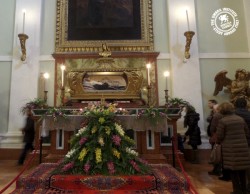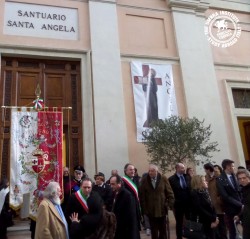The Classroom Brought to Life: Honoring Angela of Foligno


Earlier this month, Umbra students Emma Cordell and Giuseppina Rossi visited the nearby town of Foligno with Professor Adrian Hoch, Ph.D. This visit was a continuation of their fall semester participation in Hoch’s HSWS 380: Saints, Sinners and Harlots: Medieval Women in Central Italy course and provided the opportunity for the students to attend festivities in honor of one of the women studied over the course of the semester, a 3rd order Franciscan, Angela of Foligno.
“On January 4th, Giuseppina and I, accompanied by Professor Hoch, took a trip to the Umbrian town of Foligno to attend festivities celebrating Angela of Foligno,” commented Cordell. “She was sainted in October of 2013 by Pope Francis, and happened to be a major figure that we studied in Professor Hoch’s class. Witnessing these celebrations, in honor of one of the women we had been taught about, gave us a nice sense of closure to the course. It provided us an opportunity to see the subject brought to life in a way that made her life story, which has so fascinated us in class, appeal to everyone.” Emma Cordell is a Miami University of Ohio student, currently enrolled in her second semester at The Umbra Institute.

“Lo scorso semestre ho frequentato un corso, “Saints and Sinners”, il cui studio era incentrato sulle donne medievali del centro Italia diventate poi sante. È stato soprattutto questo che mi ha spinto a partecipare alla canonizzazione di Angela da Foligno, il 4 gennaio 2014. Io, la studentessa Emma Cordell e la prof.ssa Adrian Hoch, l’insegnante del corso, abbiamo partecipato alla messa delle 11, celebrata nella chiesa in cui è custodito il corpo della santa: era piena di persone, alcune delle quali avevano partecipato anche alla messa mattutina. La cerimonia è stata bella – avevo dimenticato l’odore di incenso che si sente appena si entra in chiesa. Uno dei momenti più toccanti della celebrazione è stata la fine, quando tutte le persone si sono dirette verso il corpo della santa per toccarne la bara. Oltre alla messa del mattino c’è stata anche la celebrazione delle 16.30, la più importante, accompagnata da una sfilata di ragazzi vestiti con abiti antichi, alcuni dei quali suonavano il tamburo. E’ stata un’esperienza per me estremamente interessante: è stata la prima volta in cui ho partecipato a questo tipo di evento, e non ne sono rimasta affatto delusa. Per questo vorrei ringraziare la prof.ssa Hoch e Emma per aver condiviso con me quest’esperienza.” Giuseppina Rossi è una studentessa dell’Università degli Studi di Perugia.
Umbra’s HSWS 380: Saints, Sinners and Harlots: Medieval Women in Central Italy course explores the rich textual, hagiographic, and visual records celebrating women in Central Italy during the 13th and 14th centuries. Students focus on such figures as Clare of Assisi, Catherine of Siena and Angela of Foligno, striving to understand the interconnections between popular religious display, individual lives, and the art and architecture created by a culture to exalt its spiritual heroines.